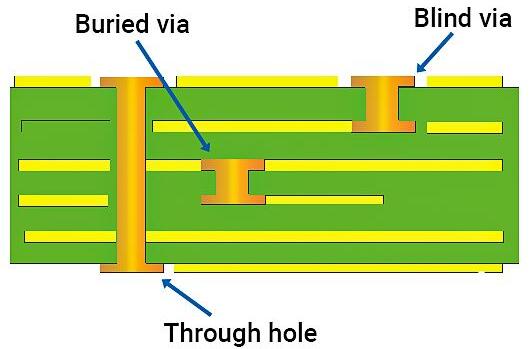Common drilling methods in PCBs include through holes, blind holes, and buried holes.

1. Through hole
Through-hole (VIA), is a common hole used to conduct or connect copper foil lines between conductive patterns in different layers of the circuit board. Such as (e.g., blind holes, buried holes), but can not insert the component lead leg or other reinforcement material copper plated holes. Because the PCB is formed by the accumulation of many copper foil layers, each layer of copper foil will be covered with a layer of insulation layer, so that the copper foil layer can not communicate with each other, and the link of its signal is by the through hole (via), so there is the title of the through hole.
Features: to meet the needs of customers, the circuit board through the hole must be forked, so the change of the traditional aluminum plug process, with white mesh to complete the circuit board surface welding and plug holes, so that its production is stable, reliable quality, more perfect use. The conduction hole mainly plays the role of connecting the circuit, along with the electronic line. The rapid development of the industry has also put forward higher requirements for the process and surface mount technology of printed circuit board production.
The process of plugging through holes is applied and born, and the following requirements should be met: 1. Copper can be found in the through-hole, and solder stopper can be plugged or not. 2. There must be tin lead in the through-hole, and there is a certain thickness requirement(4um) that shall not have solder resistance ink in the hole, resulting in tin beads in the hole. 3. The pass-through hole must have solder resistance ink plug hole, opaque, no tin ring, tin bead and flat requirements.
2. Blind holes
Blind hole: that is, the outermost circuit in the PCB and the adjacent inner layer are connected by electroplating holes because the opposite side is not visible, so it is called a blind pass. At the same time, to increase the utilization of space between PCB circuit layers, blind holes are applied. That is, a through-hole to the surface of the printed board.
Features: Blind holes are located on the top and bottom surfaces of the circuit board, with a certain depth for the link between the surface line and the inner line below, and the depth of the holes usually does not exceed a certain ratio (aperture). This production method requires special attention to the depth of the drilling hole (Z-axis) to be just right, if you do not pay attention to it, it will cause plating in the hole
Difficult so almost no factory use, you can also need to connect the circuit layer in advance of the individual circuit layer when the hole is drilled first, and finally bonded together, but the a need for a more precise positioning and alignment device.
3. Buried holes
The buried hole is the link between any circuit layers inside the PCB but is not channeled to the outer layer, and is also the meaning of a channeled hole that is not extended to the surface of the circuit board.
Features: This process can not be achieved by using the method of drilling after bonding, it is necessary to perform drilling at the time of individual circuit layers, first local bonding of the inner layer and then electroplating treatment, and finally all bonding, which is more time-consuming than the original through holes and blind holes, so the price is also the most expensive. This process is usually only used for heights. The density of the circuit board increases the usable space of other circuit layers.
In the PCB production process, drilling is very important and can not be sloppy. Because drilling is to drill out the required holes on the copper-clad plate to provide electrical connections and fixed device functions. If the operation is improper, there is a problem in the process of passing the hole, the device can not be fixed on the circuit board, the light will affect the use, and the heavy will scrap the whole board, so the drilling process is very important.
With the rapid development of the electronics industry market, a variety of new products emerge in an endless stream, more and more to the "light, thin, short, small" direction of iteration and update. PCB also began to high-density, difficult, high-precision development, because of the emergence of different through-hole types to meet the needs of the process.
In the PCB production process, drilling is very important, if the operation is improper, there is a problem in the process of passing the hole, the device can not be fixed on the circuit board, the light will affect the use, and the whole board will be scrapped. Now the common drilling holes in the printed circuit board PCB are through holes, blind holes and buried holes.